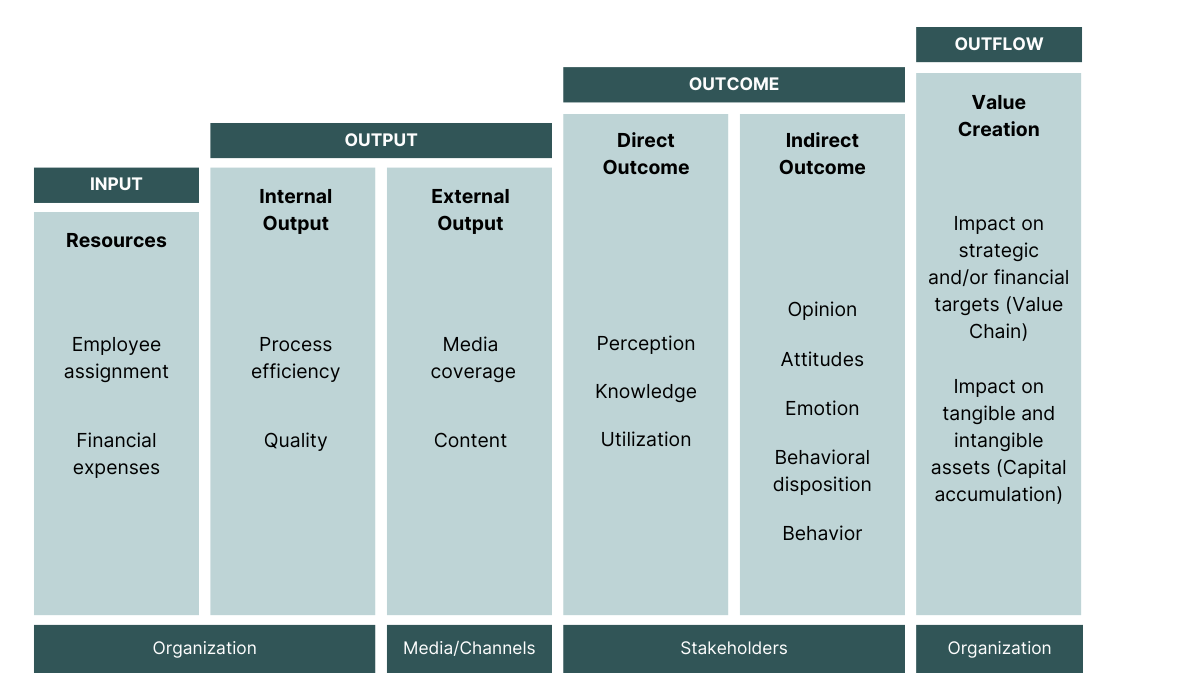
business outcomes has always been hard – but it is getting easier. These communications challenges persist across the industry, affecting how Chief Communications Officers demonstrate value and impact.
In a recent private conversation about reputation measurement with the Chief Communications Officer of an American food conglomerate, she said: “The first thing I did when I entered this role was to stop looking at data that doesn’t have an impact on sales.”
With over $7B in annual turnover and more than 30,000 employees worldwide, this company is at the forefront of the data journey that all corporate comms departments undergo.
But her concern with showing a clear return on investment in communications activities isn’t new.
From the German DPRG/ICV 2009 model for evaluation of communication to the international integrated evaluation framework from AMEC, the industry has long been pre-occupied with the need to close the loop on showing the value of communication activities – doing away with the old Advertising Value Equivalency and going all the way through to outcomes, outflow and, most importantly, business impact.

Even more so today, the ROI imperative is unavoidable, given shrinking budgets in the communications function and ever-increasing uncertainty and complexity.
As Edelman put it in its recent Future of Corporate Communications report: “At no time in history have business leaders been forced to confront such complexity [and] to meet the challenge of this moment, the corporate comms function must advance from operating as a transactional cost center … to being an indispensable partner generating measurable business value.”
Yet the struggle to connect the dots from inputs and investment to commercial outcomes and business impact continues.
According to PRWeek and Cision’s 2023 Global Comms Report, 61% of CCOs cite the “inability to measure impact effectively” as their top challenge. Why do these communication challenges still persist?
Conventional wisdom goes something like this: unlike marketing, which runs customer-facing campaigns that directly impact short-term sales, corporate comms activities aim to influence various stakeholders in various ways – the benefits of which are only seen in the long run.
That’s true. Not only can supportive behavior from customers, policymakers, talent, opinion leaders, investors, journalists, and other stakeholders not be measured in increased sales, but their improved perceptions and behavior towards a company typically relate to the company itself rather than its products. This is most likely the main reason for the ongoing challenge.

Another explanation for the communication challenges CCOs face is a shortage in data analytics skills in comms departments. Connecting the dots between activities and business impact requires monitoring and analyzing many data points.
When those connections are indirect – as described above – the analysis may require more data and greater skill. According to reports by the Page Society and the European Communication Monitor, those skills are missing.
Many tools exist today to help communicators inform, support, and optimize their activities, from stakeholder insights and content creation to tracking and collaboration platforms.
Indeed, as the Page Society states: “CCOs are beginning to develop CommTech, making their enterprises more agile, digital, and data- and analytics-driven.”
This requires the adoption of new tools and platforms – and new team structures and roles, processes, and ways of working.
As the corporate comms function becomes more data-savvy, so will its ability to optimize its activities and prove its business impact improve.
At the same time, connecting the dots is about better defining the business impact that communications make.
Undoubtedly, a direct impact on sales is the ultimate measurement of commercial value. Fortunately, though, in today’s world of stakeholder capitalism, companies are embracing a broader definition of value creation: one that focuses on the long term and considers the needs of all stakeholders and society at large.
This means that business impact can also be a recognized improvement in the company’s ESG ranking in terms of performance and perceptions. Or in the company’s ability to better attract and retain talent.
Such improvements will also benefit the company’s bottom line by reducing transaction costs and increasing stakeholder loyalty and advocacy.
Read also: Real-Time Stakeholder Communication: Why Perception Tracking Matters
Front-runners are already ahead of the game in connecting the dots: Audi uses a host of real-time KPIs to steer communications in an agile way and instill a data culture in the organization’s global communications function.
Siemens Healthineers has developed a state-of-the-art consolidated Business Intelligence dashboard that connects many data sources to show a real-time picture of the company’s communication activities and their impact.
Henkel takes a uniquely strategic approach to connect the dots, implementing continuous measurements that go through all the stages of the AMEC-integrated evaluation framework – from objectives to impact.
Even that American food conglomerate hasn’t given up on reputation measurement to prove return on investment in corporate comms.
It recently embarked on an ambitious new setup that measures real-time reputation among relevant stakeholders to generate data insights that enable real-time adjustments that unlock business results.
Communicators shouldn’t despair, then. On the contrary, they should focus on transforming their function into a data-savvy machine: by recruiting new skills, adopting new tools, and defining a clear strategy to make the function’s work more effective and demonstrably impactful.
While the holy grail of proving ROI is becoming ever more necessary, it is also becoming more achievable. And, for that, we communicators should be grateful.

As CEO of Caliber, Shahar leads a global team pioneering stakeholder intelligence — helping businesses listen to their most important audiences, manage their reputation, and build trust through real-time perception data. He holds an MBA from Columbia and frequently comments on stakeholder intelligence, corporate reputation, and branding for CNBC, Financial Times, Reuters, and others.
CCOs struggle most with measuring ROI, linking communication activities to business outcomes, limited analytics capabilities, and proving long-term value across multiple stakeholders.
Because corporate communications influences perceptions and behavior over the long term, not short-term sales. Many outcomes—trust, legitimacy, employee attraction, policy influence—don’t show up in traditional commercial metrics.
CommTech refers to tools that support data-driven communications—such as stakeholder intelligence platforms, content tools, dashboards, and collaboration systems. These help teams measure impact, track perception changes, and optimize decisions in real time.
It expands business value beyond sales to include trust, ESG performance, talent attraction, policy influence, and long-term loyalty. This broader definition aligns better with the real outcomes communications drives.
Because technology alone isn’t enough. Teams also need new processes, skills, structures, and a clearer definition of what “impact” means inside the business.
You may also be interested in
Follow Caliber
Get the results of our latest research directly in your inbox!